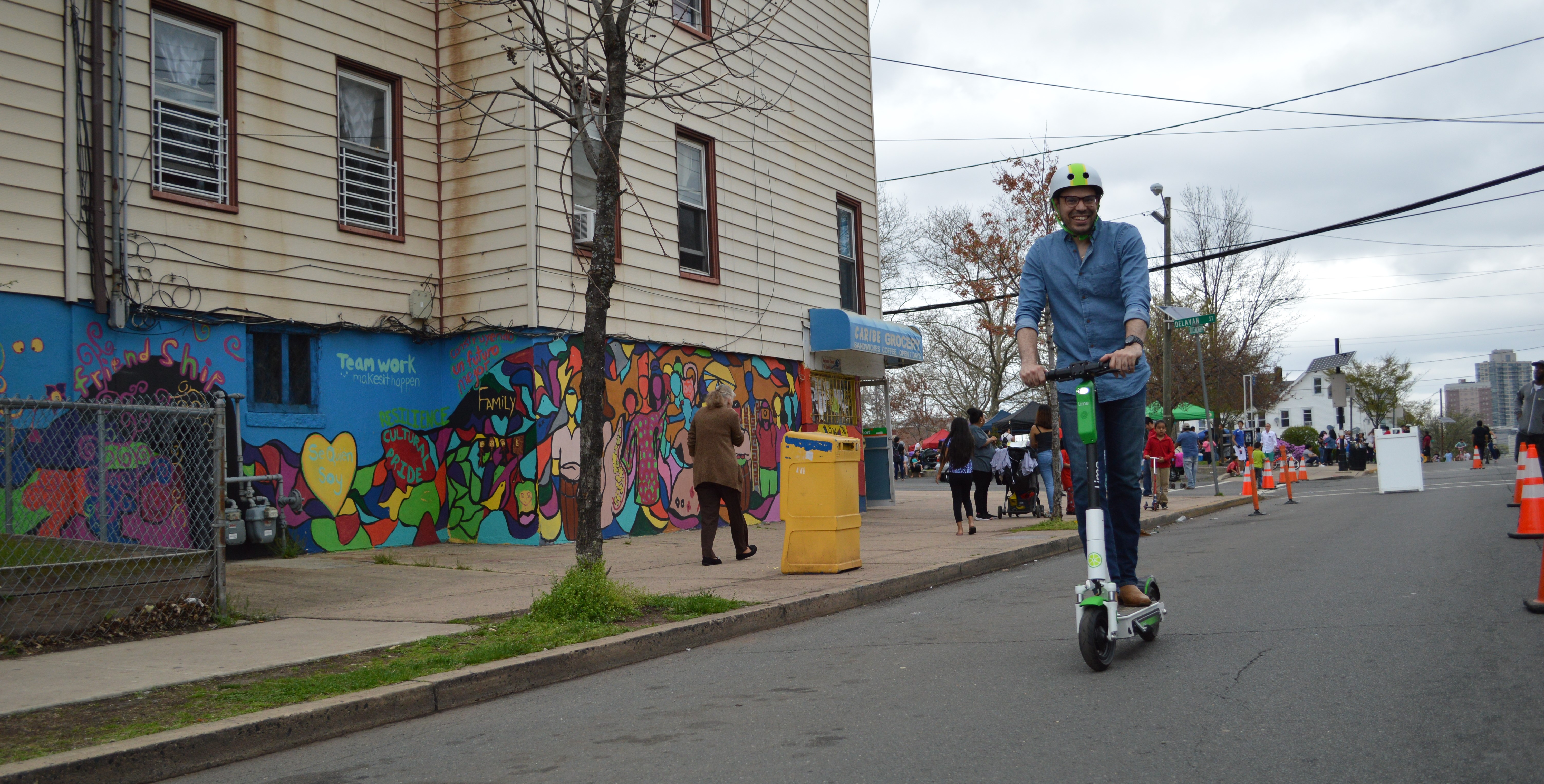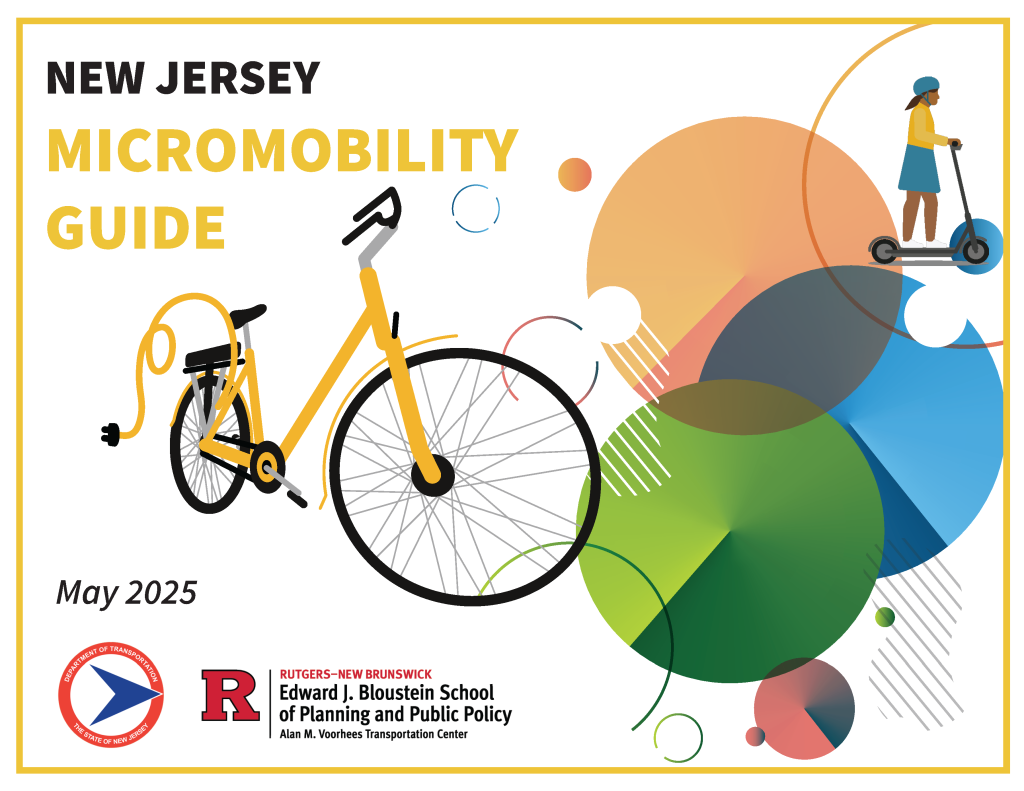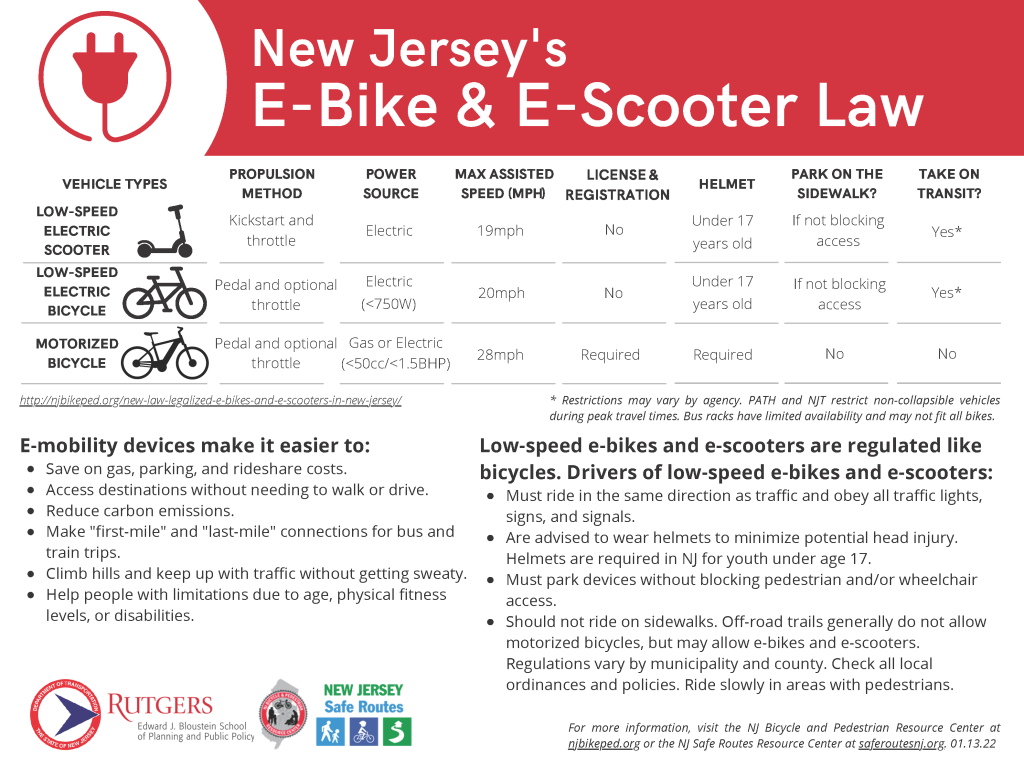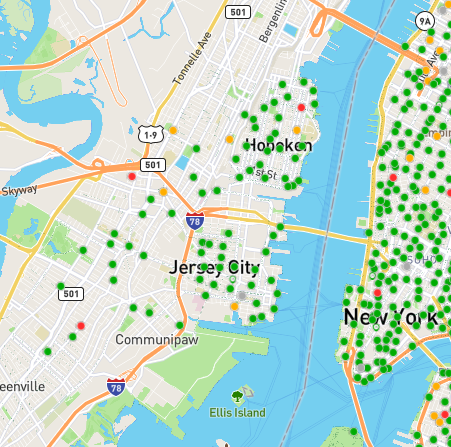E-Bikes, E-Scooters, and More in New Jersey
Welcome to your one-stop repository for information related to electric micromobility in New Jersey! “Micromobility” refers to smaller, lighter, low-speed transportation devices, which can be motorized or human-powered, and can be either shared or privately owned. (For example: bicycles, e-bikes, electric scooters, electric skateboards, and shared bicycles).
For more information, read below and be sure to check out our New Jersey Micromobility Guide which summarizes the state laws and best practices that promote safety among riders of e-bikes, e-scooters, and other forms of micromobility.
How does the New Jersey law define e-bikes?
E-bikes generally come in two forms: throttle and pedal assist. On a throttle bicycle, you can engage the throttle to propel forward using only the motor. Pedal assist bicycles give you extra power while you’re already pedaling. Some e-bikes are equipped with both modes.
Under the previous regulatory framework, e-bikes were classified as motorized bicycles (mopeds), and required registration with the MVC. However, the MVC system would not allow registration because the law was written for gas-powered vehicles. That left e-bikes in a legal gray area.
As of May 14, 2019, a brand new vehicle class was added to Title 39:4-14.16 “Low-speed electric bicycle.” This new vehicle is described as “a two or three-wheeled vehicle with fully operable pedals and an electric motor of less than 750 watts, whose maximum speed on a paved level surface, when powered solely by a motor, while operated by a person weighing 170 pounds, is less than 20 miles per hour.”
The new law allows both “pedal-assist” and “throttle” bicycles. In order to ensure that New Jersey is in line with federal definitions, the new law states that the bicycle must “meet the requirements of one of the following classifications: “class 1 low-speed electric bicycle” which means a low-speed electric bicycle equipped with a motor that provides assistance only when the rider is pedaling, and that ceases to provide assistance when the bicycle reaches the speed of 20 miles per hour; or “class 2 low-speed electric bicycle” which means a low-speed electric bicycle equipped with a motor that may be used exclusively to propel the bicycle, and that is not capable of providing assistance when the bicycle reaches the speed of 20 miles per hour.”
Low-speed electric bicycles must follow all the regulations established for traditional bicycles. This means there is no need for a license or registration. However, riders must continue to comply with all the laws that apply to vehicles, such as obeying traffic signals and following the direction of traffic. Like bicycles, e-bikes will be allowed to park on sidewalks, as long as they do not block pedestrian access. For more information on where e-bikes are allowed in New Jersey, read our blog article on this topic.
Additionally, the definition of motorized bicycles have been expanded. Aside from continuing to allow gas-powered vehicles, electric pedal bicycles that can achieve speeds between 20 mph and 28 mph now fall under this classification. These vehicles will still require a driver’s license and registration from the MVC.
Low Speed Electric Bicycles:
- 20 mph max speed
- 750 watts or less
- May be parked on sidewalks without blocking pedestrian traffic
- No license, insurance, or registration required
- Must follow all laws applicable to bicycles
- Helmet use is required for those under age 17
- May be pedal assist or throttle powered
Motorized Bicycles:
- Electric pedal bicycles that can achieve speeds between 20 and 28 mph
- Gas pedal bicycle with maximum piston displacement under 50 cc
- Require driver license, registration, and insurance
- Helmet use is required
How does the New Jersey law define e-scooters?
The word “scooter” can apply to a range of consumer products. Under the previous regulatory framework, all forms of scooters, aside from electric personal assistive mobility devices (mobility scooters for the disabled), were illegal for use on public streets in New Jersey.
The new law created a new vehicle type called a “Low-speed electric scooter” which is defined as “a scooter with a floorboard that can be stood upon by the operator, with handlebars, and an electric motor that is capable of propelling the device with or without human propulsion at a maximum speed of less than 19 miles per hour.”
E-scooters must follow all the laws that apply to bicycles. That means that riders must comply with all the laws that apply to vehicles, such as obeying traffic signals and following the direction of traffic. Like e-bikes, e-scooters will be allowed to be parked on sidewalks, as long as they do not block pedestrian access. Operation on sidewalks and trails is up to local municipalities.
Low Speed Electric Scooters:
- 19 mph max speed
- May be parked on sidewalks without blocking pedestrian traffic
- Riding on sidewalk up to each municipality
- No license, insurance, or registration required
- Must follow all laws applicable to bicycles
- Helmet use is required for those under age 17
How does New Jersey Law define other micromobility vehicles?
What about motorized skateboards, hoverboards, and more? They fall under the category of “motorized scooter.” This designation means a miniature motor vehicle and includes “pocket bikes, super pocket bikes, scooters, mini-scooters, sport scooters, mini choppers, mini motorcycles, motorized skateboards” as well as other vehicles with motors which are not manufactured to comply with Federal Motor Vehicle Safety Standards. Motorized scooters exclude motorized bicycles, low-speed vehicles, low-speed electric bicycles, or low-speed electric scooters, motorized wheelchairs, mobility scooters, or other similar mobility devices used to assist persons with physical disabilities.
New Jersey state law prohibits the operation of motorized scooters on public roads, sidewalks, or public lands. These devices may only be operated on private property and only with the consent of the owner. There are exceptions for persons with mobility-related disabilities, but they are restrictive and require a special placard from the Motor Vehicle Commission; however, the “motorized scooter” category does not include traditional motorized wheelchairs, mobility scooters, or other similar mobility devices used to assist persons with physical disabilities, so using these devices does not require permission from the MVC.

What does this mean for New Jersey?
The new law has made it easy for New Jerseyans to purchase e-bikes and e-scooters for personal use, without having to worry about making a trip to the MVC. This makes it easier to conduct trips in areas with hills, keep up with urban traffic, and arrive at destinations without sweating. Additionally, the new vehicle types open up possibilities for people with disabilities who cannot make walking or bicycle trips.
The new law also allowed shared-mobility companies such as Jump, Bird, Veo, and Lime (among others) to partner with municipalities to allow the public to rent e-bikes and e-scooters. Many municipalities have launched pilot systems over the past two years. As of January 2022, Newark, Asbury Park, and Rutgers New Brunswick have dockless e-scooter systems. Hoboken and Jersey City have joined New York City’s Citibike program, which has recently added e-bikes to their rental fleets.
Click on the links below for ordinances on e-scooters:
E-Bike & E-Scooter FAQs
- E-bikes come in two forms:
-
- Low Speed Electric Bicycles
- Reaches the speed of 20 mph max.
- Has an electric motor of 750 watts or less.
- May be parked on sidewalks without blocking pedestrian traffic.
- No license, insurance, or registration is required.
- Must follow all laws applicable to bicycles.
- Helmet use is required for those under age 17.
- May be pedal assist or throttle powered.
- Motorized Bicycles
- Reaches speeds between 20 and 28 mph.
- Gas pedal bicycle with maximum piston displacement under 50 cc.
- Requires a driver license, registration, and insurance.
- Helmet use is required.
- Low Speed Electric Bicycles
- E-scooters are:
- Reaches the speed of 19 mph max.
- May be parked on sidewalks without blocking pedestrian traffic.
- Riding on sidewalk is up to each municipality. Check local ordinances.
- No license, insurance, or registration required.
- Must follow all laws applicable to bicycles.
- Helmet use is required for those under age 17.
- Motorized scooters are:
- Vehicles with motors not manufactured to comply with Federal Motor Vehicle Safety Standards.
- Not allowed on public roads, sidewalks, or public lands.
- Examples include motorized skateboards, hoverboards, pocket bikes, and super pockets bikes.
Check out our Micromobility webpage! If you can’t find what you are looking for, be sure to ask our help desk.
- Ride in the same direction as traffic and obey all traffic lights, signs, and signals.
- It is advised to wear helmets to minimize potential head injury. Riders 17 years of age or younger must use helmet. Violators of the helmet law will receive warnings for their first offense. Parents or legal guardians may be fined a maximum of $25 for the 1st offense (after a warning has been issued) and a maximum of $100 for subsequent offense(s).
- Park devices without blocking pedestrian and/or wheelchair access.
- You should not ride on sidewalks. Off-road trails generally do not allow motorized bicycles, but may allow e-bikes and e-scooter. Check out local ordinances for any rules that may affect you in your municipality or county. Be sure to ride slowly in areas with pedestrians.
The rules for class 1 and class 2 low-speed e-bikes are similar to the laws applied to traditional bicycles. There is no license or registration required for e-bikes at the state level, although some towns may offer registration. As per NJSA 39:4-14.16, you can ride your e-bike on bike lanes, streets, highways, and roadways in New Jersey, except for those where all bicycle traffic is restricted by regulation. E-scooters must follow all the laws that apply to bicycles.
You may park your e-bike in public bicycle racks or on the sidewalk as long as it does not obstruct pedestrian movement. Like e-bikes, e-scooters are allowed to be parked on sidewalks as long as they do not block pedestrian access.
- In the case of a natural surface (wood chips or bare earth), e-bikes are not permitted on trails designated for non-motorized vehicles unless the owner of the facility, such as the local or county government, specifically allows e-bikes.
- The rules for paved bikeways and shared-use paths are the opposite; e-bikes and e-scooters are, by default, permitted on paved paths where traditional bikes are allowed, but local or county governments have the authority to restrict them.
- On state-managed facilities, the New Jersey Department of Environmental Protection allows class 1 and 2 e-bikes on improved multi-use trails with hard surfaces such as crushed stone or asphalt that are suitable for both e-bikes and traditional bicycles.
- E-bikes are permitted in all national parks on trails open to pedal bicycles, with minor exceptions.
- Since the New Jersey law specifies that local governments can restrict the use of class 1 and class 2 e-bikes on trails, even if traditional pedal bikes are allowed, be sure to check local rules and regulations before taking your e-bike or e-scooter on a trail or a boardwalk.
- NJ Transit: NJ Transit encourages the use of low-speed micromobility devices such as bicycles, e-bikes, e-scooters, segways, and hoverboards by allowing you to bring them aboard NJ Transit vehicles, including rail, light rail, and buses. Folding personal devices are always allowed on NJ Transit rail, light rail, and buses. NJ Transit does not differentiate between a traditional bicycle and a low-speed e-bike; all of these devices are considered “non-folding personal vehicles”. There is no requirement for an additional permit to carry your low-speed e-bike on NJ Transit, but charging electric vehicles on-board is prohibited. Learn more at njtransit.com/bikes.
- Non-folding personal vehicles are permitted on NJ Transit Rail with restrictions depending on train line and time of day.
- Non-folding personal vehicles are always permitted on NJ Transit buses using bicycle racks on the front or with underfloor luggage compartments on a first-come, first-served basis.
- Non-collapsible e-bikes, e-scooters and hoverboards can be carried on board Hudson-Bergen Light Rail and Newark Light Rail vehicles from 9:30 a.m. to 4 p.m. and from 7 p.m. to 6 a.m. on weekdays, and all day on Saturdays, Sundays, and state holidays.
- Both collapsible and non-collapsible personal vehicles are permitted on all River LINE light rail vehicles at all times.
- PATH: Electric bikes, scooters, or skateboards are not permitted on PATH.
- PATCO: Traditional bicycles are permitted on PATCO trains between New Jersey and Pennsylvania. E-bikes and e-scooters are not explicitly prohibited.
Municipal and county governments can restrict where class 1 and class 2 e-bikes are allowed. Be sure to check local rules and regulations before taking your e-bike or e-scooter on a boardwalk, and look out for signs when riding.



